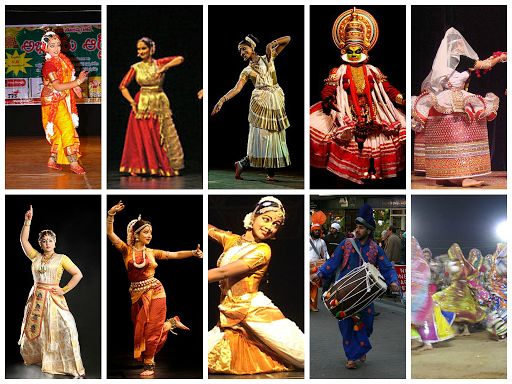You must have heard that India is famous for its food, festivals, and fashion but did you know India also has a vibrant type of folk dances for different cultural heritages? From the energetic Bhangra of Punjab to the graceful Lavani of Maharashtra, and the rhythmic beats of the Dandiya in Gujarat, these captivating art forms are deeply rooted in traditions, embodying the rhythm of rural life, the spirit of celebration, and the stories that passed down through generations, so let’s fascinate the journey across the country by exploring the colourful spectrum of India’s folk dances that reveals the history, rituals behind the regional significance and essence that makes every performance a unique reflection of the community.
1- Bhangra (Punjab)
Bhangra is a folk dance that originates from Punjab, and celebrates the region’s rich cultural heritage, characterised by its infectious rhythm, upbeat music, and vigorous movements, it is an artistic expression reflecting the exuberance and vitality of the Punjabi people performed during the harvest season, serving as a way for farmers to express their joy and gratitude for a bountiful harvest. It is the dance that incorporates a blend of traditional steps, vibrant costumes, and the rhythmic beats of instruments like the dhol (drum) and the tumbi (a string instrument) by creating an electrifying spectacle that captivates audiences worldwide and transcended its regional limitations and is now celebrated globally, making it not just a dance but a symbol of the rich and colourful tapestry is one of the Indian folk cultures.
2- Garba and Dandiya (Gujarat)
Dandiya and Garba are other forms of colourful folk dance that have their roots in Gujarat, India. Dandiya, performed with decorated sticks, and Garba, a dance form that involves circular patterns and graceful hand movements as an integral part of Gujarati culture, especially during the vibrant festival of Navratri (Nine nights). During these nine nights of celebration dedicated to the goddess Durga devotees come together and perform the traditional dances, wearing the traditional colourful dresses like Chaniya Choli and Kediya that create a joyful and festive atmosphere, involving rhythmic tapping of decorated sticks accompanied by lively music, fostering a sense of camaraderie and excitement among the participants. While Garba showcases elegant hand gestures and footwork that symbolizes the cyclical rhythm of life and the divine connection between humanity and the universe, both dances are not just a celebration of culture but also help people to express their devotion, joy, and unity, making them significant and cherished folk traditions in India.
3- Chhau (Odisha, West Bengal, and Jharkhand)
Chhau dance is a traditional art form from eastern India and depicts stories from ancient epics such as the Mahabharata and Ramayana, local folklore, and abstract themes. This dance performance was added to the list of intangible cultural heritage of humanity by UNESCO in the year 2010. The dance has three different styles, each associated with specific regions – Seraikella (Jharkhand), Purulia (West Bengal), and Mayurbhanj (Odisha). The first two styles incorporate the use of masks. Chhau dance is closely tied to regional festivals, particularly the spring festival Chaitra Parva, and has its roots in indigenous dance and martial traditions, its movements include simulated combat techniques, stylized gaits of birds and animals, and actions inspired by the daily tasks of village women.
4- Lavani (Maharashtra)
Lavani is one of the expressive folk-dance forms that finds its origins in the state of Maharashtra, India this traditional dance style has an amalgamation of music, dance, and theatrical elements performed to the lively tunes of the dholki (a percussion instrument), accompanied by soulful Lavani songs. Lavani dancers, predominantly women, adorned in colourful nine-yard sarees called Navari showcasing the graceful movements, intricate footwork, and seductive expressions and the performances revolve around themes of love, romance, and societal issues providing a unique platform for social commentary and storytelling. It has a rich history of the cultural fabric of Maharashtra, and it has evolved over the years to incorporate modern influences while retaining its traditional essence. With its dynamic choreography and spirited performances, Lavani continues to captivate audiences, both regionally and globally, making it a cherished and integral part of Maharashtra’s cultural heritage.
5- Ghoomar (Rajasthan)
It is a traditional folk dance of Rajasthan and a mesmerizing display of grace, rhythm, and vibrant colours, performed by women during special occasions and festivals, characterized by its circular movements, graceful twirls, and intricate footwork, dancers, dressed in colourful ghaghra-cholis (traditional Rajasthani attire), adorning themselves with striking jewellery by carrying pots or lamps on their heads and adds to the visual splendour in the performance. The dance derives its name from the word “ghomna,” which means to spin, and the dancers elegantly spin in circles, creating a visual spectacle. Accompanied by soulful folk songs and rhythms from traditional instruments like the dholak and sarangi, Ghoomar embodies the cultural richness and traditions of Rajasthan. The dance showcases the skill of the performers serving as a celebration of womanhood and community bond and makes an essential part of Rajasthan’s cultural heritage.
6- Bihu (Assam)
Bihu is a folk dance of Assam in India that is performed generally at the time of the Bihu festival. There are primarily three Bihu festivals that are popular in Assam namely Rongali Bihu, Kongali Bihu and Bhogali Bihu and the Bihu dance is performed during the Rongali Bihu. The energetic dance steps and quick hand movements define the Bihu dance of Assam. But that is not all as any folk dance is incomplete without its costume and jewellery and the performers of Bihu don the traditional Assamese attire.
7- Yakshagana (Karnataka)
The elaborate and expressive dance of the Yakshagana takes place at night. The dynamic costumes and makeup, along with the vibrating rhythms of the instruments, create a stimulating environment. The beating drums and the intoxicating recitation of the songs and mantras develop an electric effect during its performance, the main attractions of the Yakshagana dance are the beautiful facial expressions, dialogues, and graceful dance moves. Yakshagana is one such kind of art form that retains the old customs and history of long generations of involvement with it.
Importance of Folk Dance
- Folk dance is important because it keeps the culture alive.
- There can be no better way of expressing the ebbs and flows of life than folk dance. Folk dances of India fill this gap.
- They revived ancient culture in the time when people lived and breathed YouTube.
- In a real sense, the tribal and folk dances of India not only provide a comprehensive insight into culture & tradition but also act as a thread connecting past and future generations.
Indian folk dances are more than just expressions of culture; they are windows into the hearts and souls of the diverse communities that call India home. These dances connect people to their traditions, celebrate the changing seasons, and narrate stories that have been passed down through generations, folk dances serve as a reminder of the timeless beauty of the country’s cultural mosaic. Each dance is a testament to the spirit, creativity, and rich heritage of this extraordinary nation. They remind us that in the heart of India’s diverse cultures, there is a common thread of artistry and a celebration of life that binds its people together.































